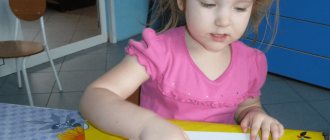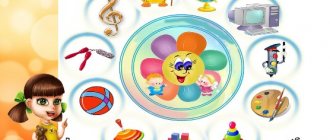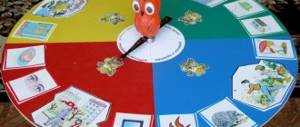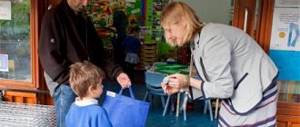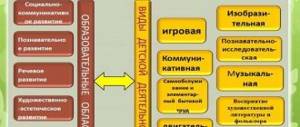Tasks for working with gifted children in primary school.
14. The desire to get to the truth in everything pushes them to real exploits. In search of the right solution, they will dig into adults, re-read a lot of literature, carry out experiments, etc.
15. Most gifted children require much less time to sleep than their peers. This is not the entire list of indicators of children's giftedness. There are about thirty of them. Here we can also add that many gifted children have a good sense of humor, interest in religion, God, and the origins of humanity.
Negative indicators of giftedness
Some people mistakenly believe that a gifted child is a soft and fluffy creature with whom no problems arise. But this is far from true. And along with positive criteria for giftedness, a number of negative ones can be named, which include the following:
• A gifted child develops unevenly. For example, at the age of five he can calculate complex geometric formulas, but at the same time he does not know how to tie his shoelaces. Or a preschool child who is already writing poems and stories, but cannot put on his shoes correctly.
• Many children with extraordinary abilities stutter.
• Due to excessive emotionality, gifted children can gesticulate strongly and make many unnecessary movements; after laughing, they may burst into tears within a minute.
• Problems communicating with other people. Parents have no choice but to come to terms with these “disadvantages” of giftedness, be patient and be lenient towards the unusual manifestations of their little genius. It is possible that all these shortcomings are a kind of “payment” for parents for the child’s originality.
Strategy for teaching gifted children.
1.Acceleration.
This strategy allows us to take into account the needs and capabilities of a certain category of children with a high rate of development. An example of this form of training could be summer and winter camps, creative workshops, and master classes.
2.Deepening.
This type of teaching strategy is effective with children who show extraordinary interest in a particular area of knowledge or activity.
3.Enrichment.
The corresponding teaching strategy is focused on qualitatively different learning content, going beyond the study of traditional topics by establishing connections with other topics, problems or disciplines. In addition, the enriched program involves teaching children a variety of ways and techniques of work.
4.Problematization.
This type of teaching strategy involves stimulating students' personal development. The focus of learning in this case is the use of original explanations, revision of existing information, search for new meanings and alternative interpretations, which contributes to the formation in students of a personal approach to the study of various fields of knowledge, as well as a reflexive level of consciousness.
Working with gifted children
Author: Kuznetsov Alexander Sergeevich
Forms and methods of working with gifted children in class and extracurricular activities
introduction
Giftedness
- this is a systemic quality of the psyche that develops throughout life, which determines the possibility of a person achieving higher (unusual, extraordinary) results in one or more types of activity compared to other people.
Large-scale activities to work with gifted children began in 1996 in connection with the adoption of the Federal Target Program “Gifted Children”.
Gifted child
- this is a child who stands out for his bright, obvious, sometimes outstanding achievements (or has internal prerequisites for such achievements) in one or another type of activity. Today, most psychologists recognize that the level, qualitative uniqueness and nature of the development of giftedness are always the result of a complex interaction of heredity (natural inclinations) and the social environment, mediated by the child’s activities (play, study, work). In this case, the child’s own activity, as well as the psychological mechanisms of personal self-development that underlie the formation and implementation of individual talent, are of particular importance.
Gifted children usually have excellent memory, which is based on early language and abstract thinking. They are distinguished by the ability to classify information and experience, the ability to widely use accumulated knowledge. A large vocabulary, accompanied by complex syntactic structures, and the ability to pose questions most often attract the attention of others to a gifted child. Little “geeks” enjoy reading dictionaries and encyclopedias, coming up with words that, in their opinion, should express their own concepts and imaginary events, and prefer games that require the activation of mental abilities.
Talented children easily cope with cognitive uncertainty. At the same time, difficulties do not force them to deviate. They enjoy complex and long-term tasks and hate it when a ready-made answer is imposed on them.
A gifted child is also distinguished by increased concentration of attention on something, perseverance in achieving results in an area that interests him. To this we must add the degree of immersion in the task.
Due to their limited life experience, such children often start enterprises that they cannot handle. They need understanding and some guidance from adults; attention should not be focused on their failures; it is better to try again together.
Gifted and talented children have the following characteristics:
- A highly developed sense of justice, which manifests itself very early. Gifted children have very broad personal value systems.
- They are acutely aware of social injustice. They set high demands on themselves and on others and respond vividly to truth, justice, harmony and nature.
- They cannot clearly differentiate between reality and fantasy.
- Well developed sense of humor. Talented people love inconsistencies, wordplay, tricks, and often see humor where their peers do not. Humor can be a saving grace and a healthy shield for delicate psyches that need protection from painful blows inflicted by less susceptible people.
- Gifted children are constantly trying to solve problems that they are not yet able to handle. From the point of view of their development, such attempts are useful.
- Gifted children tend to have exaggerated fears because they are able to imagine many dangerous consequences.
- They are extremely susceptible to non-verbal manifestations of feelings from others and are very susceptible to silent tension that arises around them.
Based on the idea of B.F. Lomov on the identification of three functions of the psyche, then the model of key competencies can be depicted in the form of a pyramid, the tops of which are: intellectual, communicative and informational competencies. And since
At the same time, the activities of teachers include:
- implementation of a person-oriented pedagogical approach for the purpose of harmonious development of a person as a subject of creative activity;
- creation of a system of developmental and developmental education based on psychological and pedagogical research, ensuring early identification and disclosure of the creative potential of children with an increased level of learning ability;
- studying the factors of psychological and pedagogical assistance in the processes of personality formation, the effective implementation of students’ cognitive abilities
- introduction into the educational process of the idea of harmonization of all academic disciplines in the basic curriculum system, which is a condition for ensuring the dominant role of cognitive motivations, activation of all types and forms of creative self-realization of the individual.
- managing the process of developing students' intellectual abilities.
The structural integrity of the educational process is based on the interdependence of structuring components: ideas - content - updating the content of training, variability of educational programs - determining individual educational trajectories - technologies - developmental teaching methods and practice - educational activities - family assistance in the education and upbringing of children.
To develop a person, it is necessary rationally, i.e. in accordance with his “self”, choose the goals, content, methods, forms of education. As evidenced by the experience of a comprehensive school, i.e. where traditional didactics work, the main thing is missed; to what extent and whether there will be any demand for what is given to the person who is being trained, educated, developed.
The pedagogical system is built on four basic ideas:
- on the awareness of the self-worth of each student as a unique, unrepeatable personality;
- on the inexhaustibility of the development possibilities of every child, including his creative abilities;
- on the priority of internal freedom over external freedom as freedom necessary for creative self-development;
- on understanding the nature of creative self-development as an integral characteristic of the “self”, the initial components of which are self-knowledge, creative self-determination, self-organization, self-government, creative self-improvement and self-realization of the student’s personality.
Identification of gifted children should begin already in elementary school on the basis of observation, study of psychological characteristics, speech, memory, and logical thinking. Working with gifted and capable students, their search, identification and development should become one of the most important aspects of the school’s activities.
Conventionally, three categories of gifted children can be distinguished:
- Children with an unusually high general level of mental development, all other things being equal (such children are most often found in preschool and primary school age).
- Children with signs of special mental giftedness - in a certain field of science (teenage image).
- Students who, for some reason, do not achieve success in their studies, but have bright cognitive activity, an original mental makeup, and extraordinary mental reserves (more often found in high school age).
Principles of pedagogical activity in working with gifted children:
- the principle of maximum diversity of opportunities provided for personal development;
- the principle of increasing the role of extracurricular activities;
- the principle of individualization and differentiation of training;
- the principle of creating conditions for students to work together with minimal teacher participation;
- the principle of freedom for students to choose additional educational services, assistance, and mentoring.
Conditions for successful work with gifted students.
Awareness of the importance of this work by each member of the team and, in connection with this, increased attention to the problem of developing positive motivation for learning.
Creation and continuous improvement of a methodological system for working with gifted children.
Recognition by the staff of teachers and school management that the implementation of a system of work with gifted children is one of the priority areas of the school’s work.
Involving first of all teachers with certain qualities in working with gifted students:
- A teacher for a gifted child is a person who responds productively to challenges, who can take criticism and not suffer from stress when working with people more capable and knowledgeable than himself. The interaction of a teacher with a gifted student should be aimed at the optimal development of abilities, be of a helping, supportive nature, and be non-directive;
- The teacher believes in his own competence and ability to solve emerging problems. He is ready to bear responsibility for the decisions made, and at the same time is confident in his human attractiveness and worth;
- the teacher considers others capable of solving their problems independently, believes in their friendliness and that they have positive intentions, they have a sense of self-worth that should be valued, respected and protected;
- The teacher strives for intellectual self-improvement, willingly works to expand his own knowledge, is ready to learn from others, engage in self-education and self-development.
The teacher must be:
- passionate about his work;
- capable of experimental, scientific and creative activities;
- professionally competent;
- intellectual, moral and erudite;
- a conductor of advanced pedagogical technologies;
- psychologist, educator and skilled organizer of the educational process;
- an expert in all areas of human life.
Forms of work with gifted students:
- creative workshops;
- group classes on parallel classes with strong students;
- electives;
- interest groups;
- research activities;
- NOU "Iskatel"
- competitions;
- intellectual marathon;
- scientific and practical conferences;
- participation in Olympiads;
- work according to individual plans;
- cooperation with other schools and universities.
Some problems in the development of gifted children.
Identifying gifted children and developing their abilities is one of the tasks of a civilized society. This task is quite difficult in its practical implementation, since it is quite difficult to find a gifted person, and even more so to educate him in accordance with his individual characteristics. We can distinguish two goals for the development process of talented children.
First
— creating the opportunity for the most complete realization of the abilities and inclinations of a gifted child. To achieve this goal, it is necessary to carry out a number of activities aimed at studying the initial conditions of activity. These include: isolating criteria for giftedness, identifying children according to these criteria, studying their interests and initial level of development. Further work with talented students will include the development of a theoretical framework and practical plans for collective, group and individual lessons, as well as actions to analyze and systematize teaching activities.
Second
- education of a balanced, intelligent representative of society who will be able to realize his potential based on his interests. This goal involves the study and development of the child’s individual personal qualities, as well as the creation of certain physical and psychological conditions for his development. Such actions can create a favorable environment for the formation of a personality with pre-planned qualities. Despite the fact that the first installation on some provisions contradicts the present one, they cannot be separated or singled out at the expense of the other - they are of equal importance for the development of a gifted person.
Pedagogical programs for the development of gifted children must be built on the basis that both of these tasks must be solved simultaneously. The construction of such programs is influenced not only by the general requirements of pedagogy and psychology, but also by the personality and character of the child, that is, they must be largely individual in nature.
Giftedness is a complex phenomenon and has its positive and negative consequences. Positive manifestations of giftedness include good verbal abilities, constancy, independence, creativity, variety of interests, a sense of value, good memory, perseverance, abstract thinking, etc. Negative ones include individualism, different speed of thinking and writing, instability of interests, manifestation of dictatorship, increased demands and intolerance.
Considering the ambiguity of views on giftedness and its manifestations, as well as the fact that the same word defines different concepts in everyday life and science, it is difficult to give a comprehensive and accurate definition of this phenomenon.
Identification of giftedness depends on many factors, so it is necessary to use all possible sources of information about the child. Only after comparing information obtained from various sources can any conclusions be drawn. In standard life situations, stories, comments and judgments of teachers, parents, peers and friends, as well as the results of various tests can be used as sources.
They try to raise and train a gifted child in such a way that he represents the interests of the society that raised him. But it is talented children who can cause the greatest problems in learning. First of all, this is due to their advanced development and unconventional views on the world around them. Quite often, gifted children do not want to comply with general requirements at school: they do not do homework, do not want to learn step by step what they already know, etc. Along with this problem, there is another one - precocious children think much faster than they write. This leads to the fact that their work is poorly designed, sloppy, and looks unfinished. In some cases, this can lead to a complete refusal of the child to record his thoughts.
Such cases are rare; instability of interests is more common, which leads to a situation where the child does not know what he wants to become in the future. Typically, gifted children show increased demands on themselves and others, and intolerance towards violators of their own canons. Such features of behavior and consciousness allow a gifted child to abandon idols and authorities, which, on the one hand, complicates the learning process, on the other, helps to form his own style. In the early stages of working with gifted children, another unpleasant feature can be observed - superficiality of knowledge. This is explained by the multiplicity of interests of the child, his desire to engage in everything in which he is interested.
It should also be said that gifted children cause inconvenience not only to others, but often to themselves. This is most clearly manifested in communication, that is, problems arise in interpersonal communication of gifted children. Taking on the role of organizer and leader at an early age, they thereby cause dissatisfaction on the part of other participants in communication or play. This dissatisfaction is stronger the less understanding of the originality of the person who has taken power into his own hands. Later, gifted children tend to command and control others, and become more rigid and intolerant.
This fact can be viewed from different points of view: if a talented child makes every effort to attract attention to his personality, then he will have high authority and respect from the group in which he develops; and, on the contrary, unclaimed managerial talents lead to the fact that a person is rejected by the team. In the first case, a favorable psychological environment is created for further personal development, in the second, conflicts can lead to a complete loss of interest in further development.
The above facts lead to the conclusion that one of the most important tasks of a teacher when working with gifted children is to create a favorable environment in the team and resolve conflict situations.
It is important to note that overprotection of talent can lead to sad consequences - deification of oneself and humiliation of others, as well as refusal of further self-improvement. comments powered by HyperComments
Working with gifted children in 1st grade material (1st grade) on the topic
Working with gifted 1st grade students
2018-2019 academic year
Relevance - the need to support the rights of gifted and talented children to the full development and realization of their giftedness;
- identification of gifted and talented children;
-analysis of the student’s special successes and achievements;
-creation of a data bank on talented and gifted children;
- diagnostics of children's potential;
-continuity.
Principles of work of a teacher with gifted children:
- the principle of maximum diversity of opportunities provided for personal development;
- the principle of increasing the role of extracurricular activities;
- the principle of individualization and differentiation of training;
- the principle of creating conditions for students to work together with minimal teacher participation;
- the principle of freedom for students to choose additional educational services, assistance, and mentoring.
Goals of working with gifted children
- Identification of gifted children.
- Creating conditions for the optimal development of gifted children, whose talent may not yet be manifested at the moment, as well as simply capable children, for whom there is serious hope for a qualitative leap in the development of abilities
- Development and development of socially valuable competencies among students.
Conditions for successful work with gifted students
- Awareness of the importance of this work by each member of the team and, in connection with this, increased attention to the problem of developing positive motivation for learning. Creation and continuous improvement of a methodological system for working with gifted children. Recognition by the teaching staff and school management that the implementation of a system of work with gifted children is one of the priority areas of the educational institution’s work.
Forms of work with gifted students
- associations of additional education;
- interest groups;
- competitions and conferences;
- intellectual marathon;
- participation in Olympiads;
- work according to individual plans;
Encouraging gifted children
— Competition “Student of the Year”;
— Rewarding students at the final line.
Working with parents of gifted children
— Psychological support for parents of gifted children
— Joint practical activities of a gifted child and parents
— Support and encouragement of parents of gifted children at the school level.
Plan for working with gifted children
| № | The content of the work | date | Responsible |
| 1 | Adjust the list of capable children indicating the subject or direction. | September | teacher |
| 2 | Make a schedule of regular classes and keep a log of these classes. | during a year | teacher |
| 3 | Carry out an individual approach to this category of children in the classroom, using differentiated cards, punched cards, and additional teaching material. | during a year | teacher |
| 4 | Involve motivated students in helping low-performing students in the classroom. | during a year | teacher |
| 5 | To attract gifted students to participate in olympiads and marathons in subjects in order to maximize their potential. | according to plan | teacher |
| 6 | Conduct pedagogical diagnostics to monitor the development of each motivated child. | at the end of the quarter | teacher |
| 7 | Submit a report on work with gifted children at the Moscow Region. | on schedule | teacher |
| 8 | Monitor compliance with health-saving technologies when working with children. | during a year | teacher |
| 9 | Conduct pedagogical consultations with parents of capable children. | during a year | teacher |
| 10 | Continue collecting information and materials on all aspects of the activities of capable children and systematize them in individual student folders. | during a year | teacher |
| 11 | Interact with additional education teachers working with capable children. | during a year | teacher |
Individual work
1. Full name students - Student A
2. Class 1
3. What subjects will he study - mathematics, literary reading, Russian language, the world around him.
Tools for working with students
1) creating a favorable atmosphere in the classroom;
2 freeing schoolchildren from fear of mistakes, creating a situation of free choice and success;
3 orienting children towards values: man, family, fatherland, work, knowledge, culture, world, which cover the most important aspects of activity;
5. How long does this work last: academic year
| № lesson | Goals of work. | Subject | the date of the | Completion mark | |
| Plan | fact | ||||
| 1 | 1. Development of logical and creative thinking. | Solving puzzles, mathematical crosswords, entertaining exercises. Learning to solve and compose puzzles using the presentation “Rebuses from A to Z” | 05.09 | ||
| 2 | 2. Development of computing skills. | Solving “mathematical chains”, coloring pictures in given colors, depending on the obtained calculation result. | 19.09 | ||
| 3 | 3. Development of spatial thinking. | Recognition of geometric shapes. | 03.10 | ||
| 4 | 4. Development of imagination. | Making drawings and applications on the topic: “What does a number look like?”, “What does a geometric figure look like?” | 17.10 | ||
| 5 | 5. Check the acquired knowledge and level of development. | Conducting initial, intermediate and final diagnostics. | 07.11 | ||
| 6 | 1) Formation of graphic skills in first-graders | Compiling plot and descriptive stories (based on pictures). Practice restoring deformed text.. | 14.11 | ||
| 7 | 2) Development of memory, attention, logical thinking, creation of positive motivation for learning. | Improving dialogical and forming monologue speech of students through specially selected texts. | 22.11 | ||
| 8 | 3) Creating positive motivation for learning. | Solving puzzles and crosswords. Training in independent work with sources of information: reference books, encyclopedias, dictionaries. | 28.11 | ||
| 9 | 4) Development of spatial thinking and imagination, development of fine motor skills | Quiz on fairy tales and stories by children's writers; making illustrations for fragments of works and organizing an exhibition of works. | 05.12 | ||
| 10 | 5). Check your knowledge and level of development. | Participation in an intellectual marathon. | 12.12 | ||
| 11 | 1) Develop logic and independent thinking, form an ecological culture. | Conservation of rare plants and animals. Red Book. . | 19.12 | ||
| 12 | 4) To develop general educational skills: to perceive a problem, put forward a hypothesis, make generalizations and conclusions; navigate in space and time; | Orientation in the area relative to your own body, by the sun and local signs. Change of seasons. | 26.12 | ||
| 13 | 5) Influence the development of emotional-volitional, moral qualities of the individual; to cultivate a sense of patriotism and love for the Motherland, to promote aesthetic education. | The beauty and diversity of Russian nature. . | 17.01 | ||
| 14 | 6). Check your knowledge and level of development. | Learning to solve and compose puzzles using the presentation “Rebuses from A to Z | 23.01 | ||
| 15 | 1. Development of logical and creative thinking. | Solving puzzles, mathematical crosswords, entertaining exercises.” | 30.01 | ||
| 16 | 2. Development of computing skills. | Solving “mathematical chains”, coloring pictures in given colors, depending on the obtained calculation result. | 06.02 | ||
| 17 | 3. Development of spatial thinking. | . Learning how to independently compose a graphic dictation for friends. | 20.02 | ||
| 18 | 4. Development of imagination. | Compiling plot and descriptive stories (based on pictures). | 27.02 | ||
| 19 | 1) Formation of graphic skills in first-graders | Practice restoring deformed text. | 06.03 | ||
| 20 | 2) Development of memory, attention, logical thinking, creation of positive motivation for learning. | Improving dialogical and forming monologue speech of students through specially selected texts | 13.03 | ||
| 21 | 3) Creating positive motivation for learning. | Solving puzzles and crosswords. Training in independent work with sources of information: reference books, encyclopedias, dictionaries. | 20.03 | ||
| 22 | 4) Development of spatial thinking and imagination, development of fine motor skills | Conducting quizzes on fairy tales and stories by children's writers. | 03.04 | ||
| 23 | 5). Check your knowledge and level of development. | . Compiling plot and descriptive stories (based on pictures). | 10.04 | ||
| 24 | 1) Development of coherent speech, enrichment and activation of children’s vocabulary. | Practice restoring deformed text. | 17.04 | ||
| 25 | 2) Formation of the basics of a culture of verbal communication as an integral part of a person’s general culture. | Practice restoring deformed text | 24.04 | ||
| 26 | 3) Development of linguistic erudition, interest in language and speech creativity. | Solving puzzles and crosswords. | 01.05 | ||
| 27 | 4) Fostering a love of reading, developing cognitive interest in children's books, broadening one's horizons. | Learning the ability to understand the actions and motives of the characters’ behavior, to express one’s attitude towards them; | 08.05 | ||
| 28 | 5) Developing the skill of conscious, correct and expressive reading. | Practice restoring deformed text | 15.05 | ||
| Solving puzzles and crosswords. | |||||
